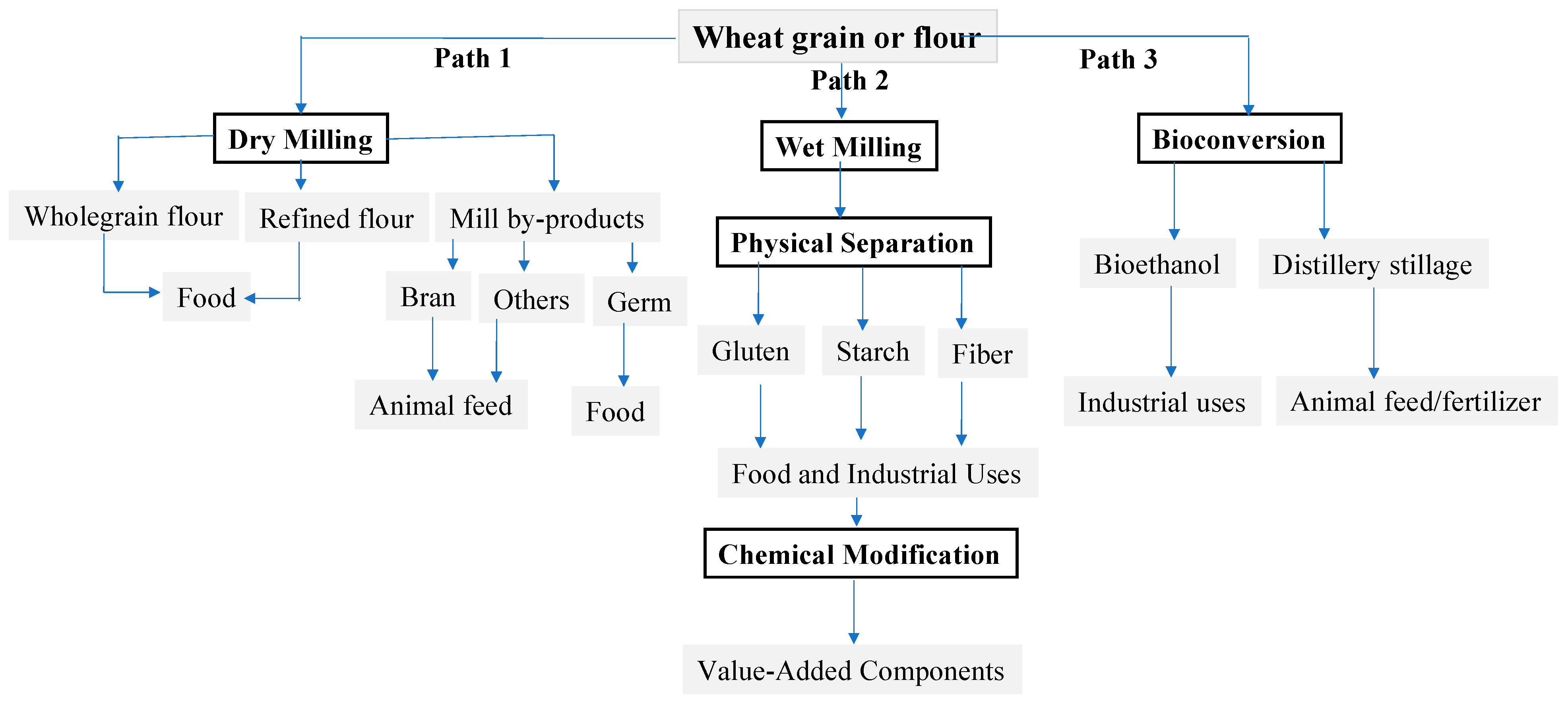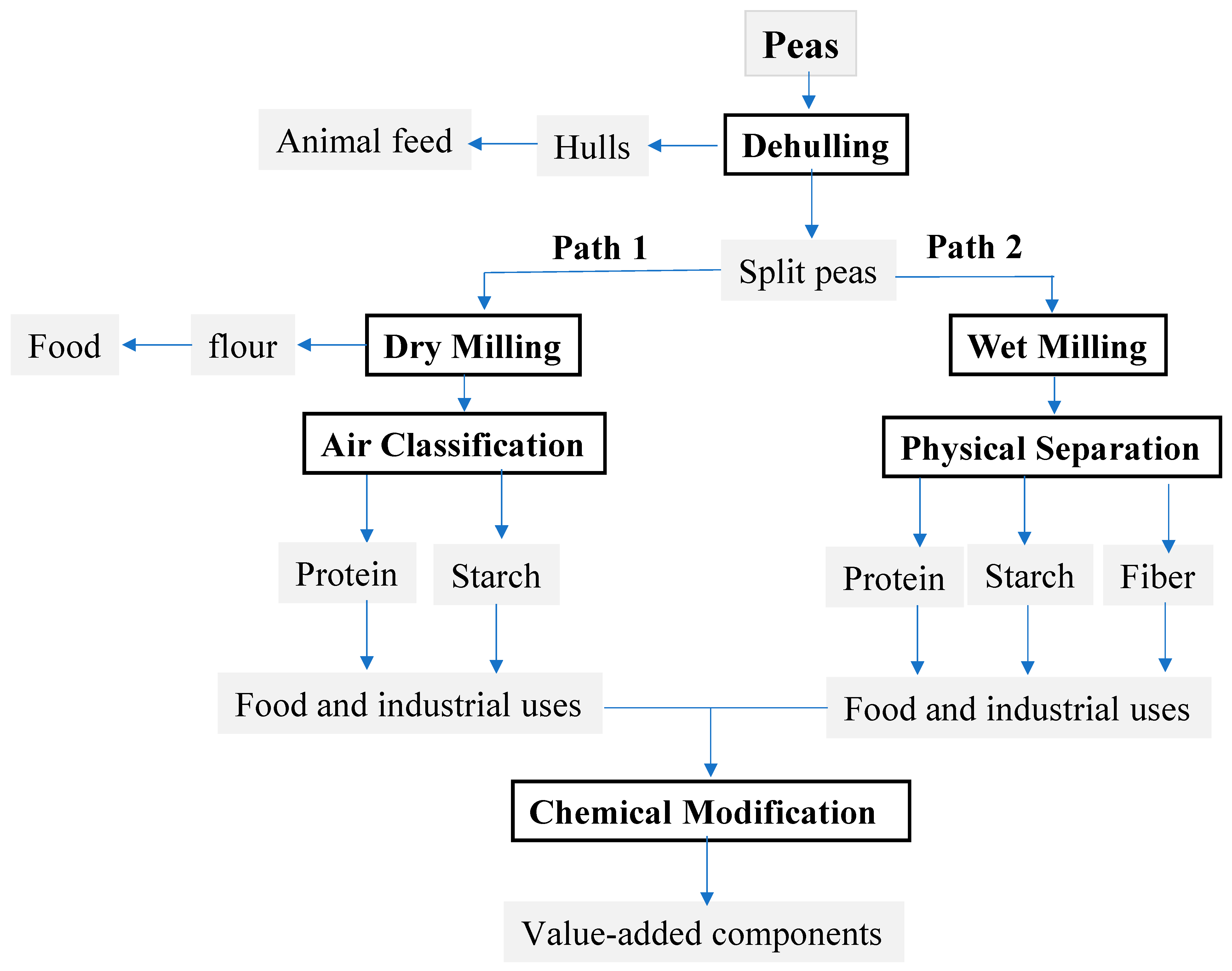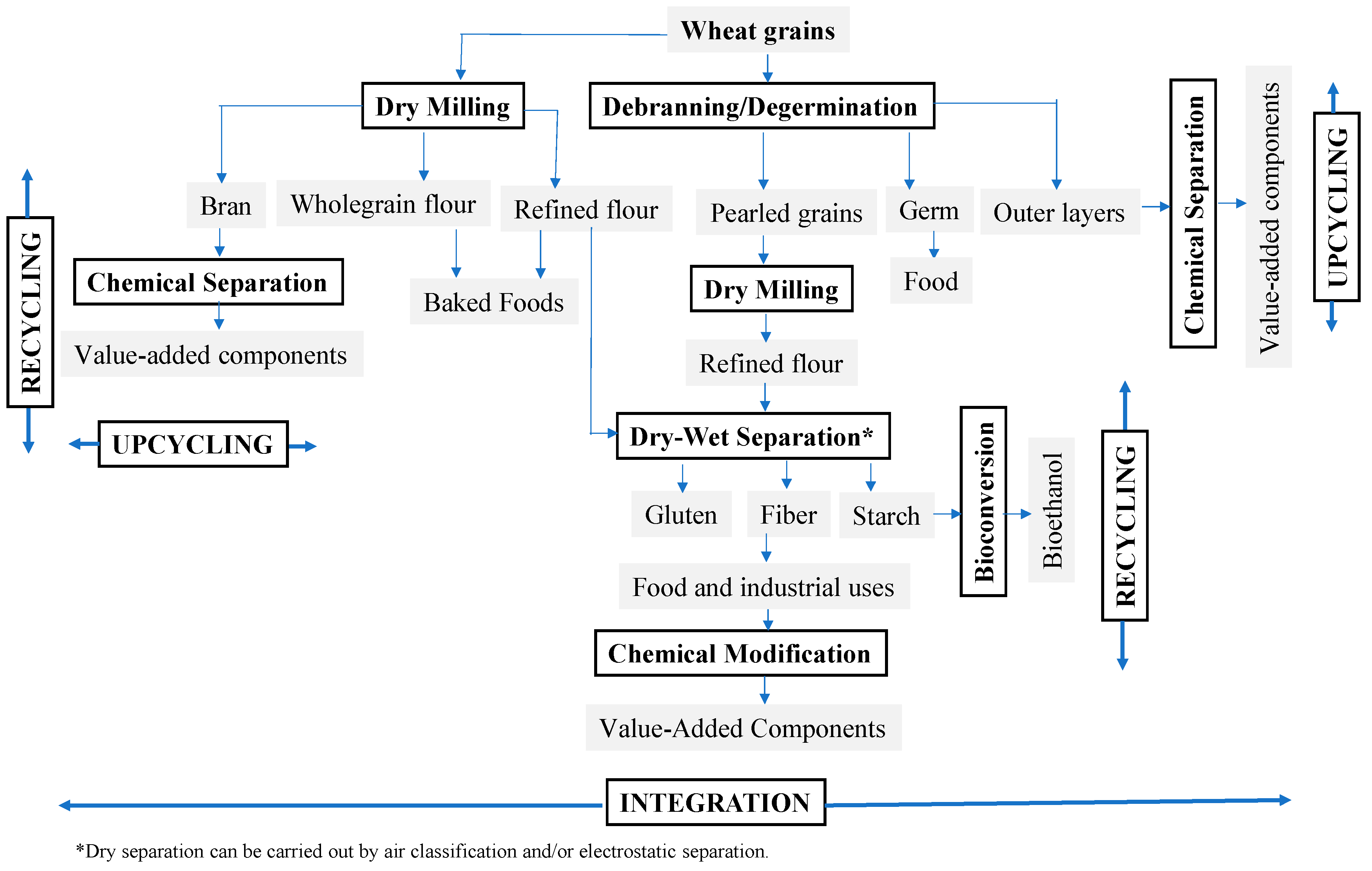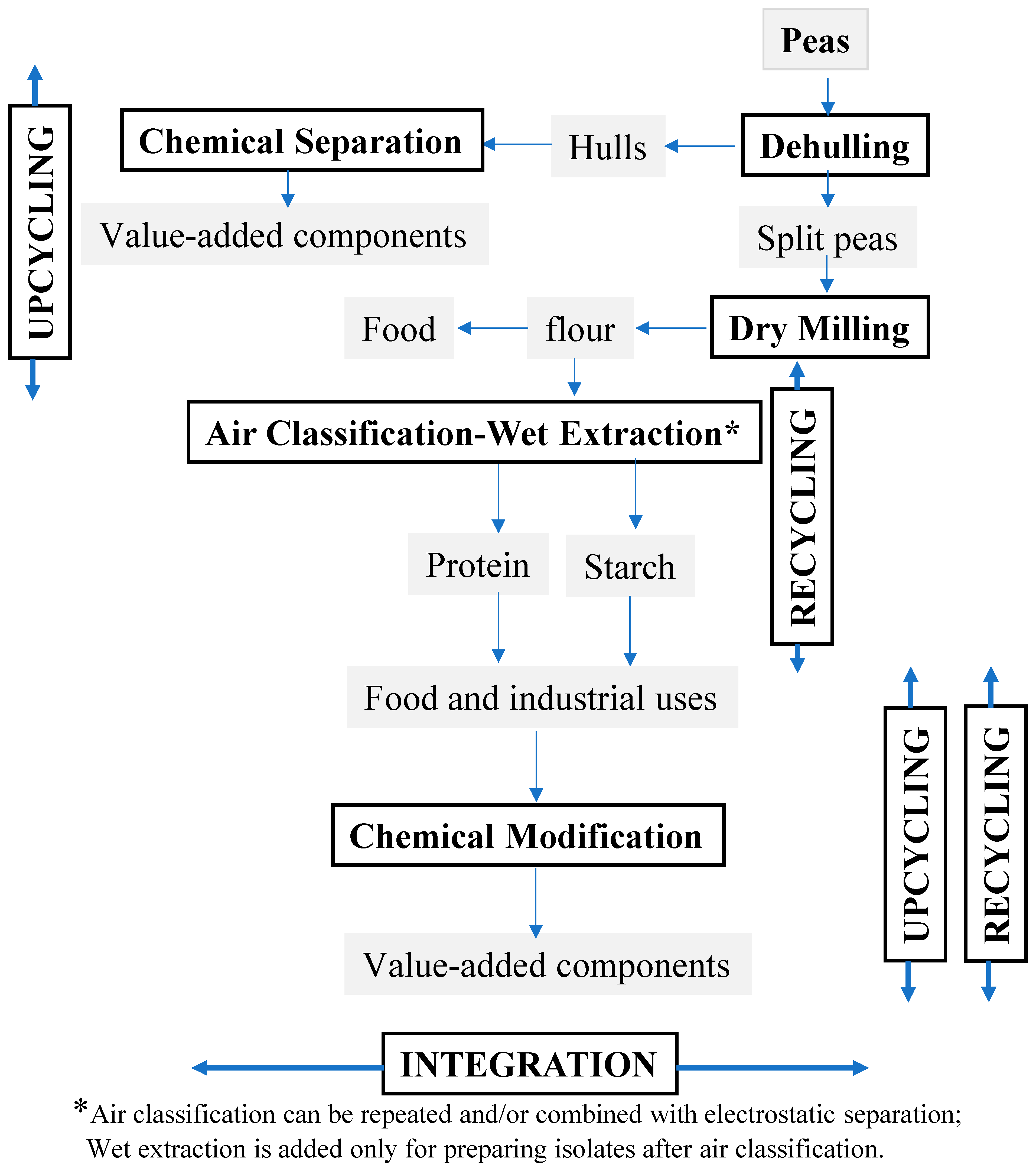Insights into Grain Milling and Fractionation Practices for Improved Food Sustainability with Emphasis on Wheat and Peas
Abstract
:1. Introduction
2. Characterization and Fractionation of Grains
3. Limitations of Current Grain Milling and Fractionation Practices
4. Sustainable Grain Processing System
5. Conclusions
Funding
Institutional Review Board Statement
Informed Consent Statement
Data Availability Statement
Acknowledgments
Conflicts of Interest
References
- FAO. Food Balance Sheets—A Handbook (fao.org). 2024. Available online: https://openknowledge.fao.org/home (accessed on 26 April 2024).
- Didinger, C.; Thompson, H.J. The role of pulses in improving human health: A review. Legume Sci. 2022, 4, e147. [Google Scholar] [CrossRef]
- Guo, H.; Wu, H.; Sajid, A.; Li, Z. Whole grain cereals: The potential roles of functional components in human health. Crit. Rev. Food Sci. Nutr. 2022, 62, 8388–8402. [Google Scholar] [CrossRef]
- Mudryj, A.N.; Yu, N.; Aukema, H.M. Nutritional and health benefits of pulses. Appl. Physiol. Nutr. Metab. 2014, 39, 1197–1204. [Google Scholar] [CrossRef] [PubMed]
- Pal, M.; Molnár, J. Growing importance of cereals in nutrition and healthy life. Int. J. Food Sci. Agric. 2021, 5, 575–577. [Google Scholar] [CrossRef]
- Tharanathan, R.N.; Mahadevamma, S. Grain legumes—A boon to human nutrition. Trends Food Sci. Technol. 2003, 14, 507–518. [Google Scholar] [CrossRef]
- Brankatschk, G.; Finkbeiner, M. Modeling crop rotation in agricultural LCAs—Challenges and potential solutions. Agric. Syst. 2015, 138, 66–76. [Google Scholar] [CrossRef]
- Xu, X.; Sharma, P.; Shu, S.; Lin, T.S.; Ciais, P.; Tubiello, F.N.; Smith, P.; Campbell, N.; Jain, A.K. Global greenhouse gas emissions from animal-based foods are twice those of plant-based foods. Nat. Food. 2021, 2, 724–732. [Google Scholar] [CrossRef]
- Pulivarthi, M.K.; Buenavista, R.M.; Bangar, S.P.; Li, Y.; Pordesimo, L.O.; Bean, S.R.; Siliveru, K. Dry fractionation process operations in the production of protein concentrates: A review. Compr. Rev. Food Sci. Food Saf. 2023, 6, 4670–4697. [Google Scholar] [CrossRef] [PubMed]
- Khan, J.; Khan, M.Z.; Ma, Y.; Meng, Y.; Mushtaq, A.; Shen, Q.; Xue, Y. Overview of the composition of whole grains’ phenolic acids and dietary fibre and their effect on chronic non-communicable diseases. Int. J. Environ. Res. Public Health 2022, 19, 3042. [Google Scholar] [CrossRef]
- Abdel-Aal, E.-S.M.; Rabalski, I. Antioxidant properties of high-Lutein grain-based functional foods in comparison with ferulic acid and lutein. Am. J. Biomed. Sci. 2013, 5, 109–125. [Google Scholar] [CrossRef]
- Gamel, T.H.; Abdel-Aal, E.-S.M.; Tucker, A.J.; Pare, S.M.; Faughnan, K.; O’Brien, C.D.; Dykun, A.; Rabalski, I.; Pickard, M.; Wright, A.J. Consumption of whole purple and regular wheat modestly improves metabolic markers in adults with elevated high-sensitivity C-reactive protein: A randomised, single-blind parallel-arm study. Br. J. Nutr. 2020, 124, 1179–1189. [Google Scholar] [CrossRef] [PubMed]
- Shipp, J.; Abdel-Aal, E.-S.M. Food applications and physiological effects of anthocyanins as functional food ingredients. Open Food Sci. J. 2010, 4, 7–22. [Google Scholar] [CrossRef]
- Temba, M.C.; Njobeh, P.B.; Adebo, O.A.; Olugbile, A.O.; Kayitesi, E. The role of compositing cereals with legumes to alleviate protein energy malnutrition in Africa. Int. J. Food Sci. Technol. 2016, 51, 543–554. [Google Scholar] [CrossRef]
- Agah, S.; Kim, H.; Mertens-Talcott, S.U.; Awika, J.M. Complementary cereals and legumes for health: Synergistic interaction of sorghum flavones and cowpea flavonols against LPS-induced inflammation in colonic myofibroblasts. Mol. Nutr. Food Res. 2017, 61, 1600625. [Google Scholar] [CrossRef] [PubMed]
- UN. Population|United Nations. Available online: https://www.un.org/en/global-issues/population#:~:text=The%20world%20population%20is%20projected,surrounding%20these%20latest%20population%20projections (accessed on 22 April 2024).
- Quintieri, L.; Koo, O.K.; Caleb, O.J. Fight against food waste: Combating contamination and spoilage. Front. Microbiol. 2023, 14, 1265477. [Google Scholar] [CrossRef] [PubMed]
- Neufingerl, N.; Eilander, A. Nutrient intake and status in adults consuming plant-based diets compared to meat-eaters: A systematic review. Nutrients 2022, 14, 29. [Google Scholar] [CrossRef] [PubMed]
- Evers, A.D.; Blankeney, A.B.; O’Brien, L. Cereal structure and composition. Aust. J. Agric. Res. 1999, 50, 629–650. [Google Scholar] [CrossRef]
- Malovichko, Y.V.; Shikov, A.E.; Nizhnikov, A.A.; Antonets, K.S. Temporal control of seed development in dicots: Molecular bases, ecological impact and possible evolutionary ramifications. Int. J. Mol. Sci. 2021, 22, 9252. [Google Scholar] [CrossRef] [PubMed]
- Sabelli, P.A. Seed Development: A Comparative Overview on Biology of Morphology, Physiology, and Biochemistry between Monocot and Dicot Plants. In Seed Development: OMICS Technologies toward Improvement of Seed Quality and Crop Yield; Agrawal, G., Rakwal, R., Eds.; Springer: Dordrecht, The Netherlands, 2012; pp. 3–25. [Google Scholar]
- Assatory, A.; Vitelli, M.; Rajabzadeh, A.R.; Legge, R.L. Dry fractionation methods for plant protein, starch and fiber enrichment: A review. Trends Food Sci. Technol. 2019, 86, 340–351. [Google Scholar] [CrossRef]
- Moller, A.C.; Li, J.; van der Goot, A.J.; van der Padt, A. A water-only process to fractionate yellow peas into its constituents. Innov. Food Sci. Eng. Technol. 2022, 75, 102894. [Google Scholar] [CrossRef]
- Otto, T.; Baik, B.-k.; Czuchajowska, Z. Wet fractionation of Garbanvzo bean and pea flours. Cereal Chem. 1997, 74, 141–146. [Google Scholar] [CrossRef]
- Pelgrom, P.J.M.; Wang, J.; Boom, R.M.; Schutyser, M.A.I. Pre- and post-treatment enhance the protein enrichment from milling and air classification of legumes. J. Food Eng. 2015, 155, 53–61. [Google Scholar] [CrossRef]
- Sayaslan, A. Wet milling of wheat flour: Industrial processes and small-scale test methods. LWT-Food Sci. Technol. 2004, 37, 499–515. [Google Scholar] [CrossRef]
- Schutyser, M.A.I.; van der Goot, A.J. The potential of dry fractionation processes for sustainable plant and protein production. Trends Food Sci. Technol. 2011, 22, 154–164. [Google Scholar] [CrossRef]
- Stone, A.K.; Shi, D.; Marinangeli, C.P.F.; Carlin, J.; Nickerson, M.T. Current review of faba bean protein fractionation and its value-added utilization in foods. Sustain. Food Protein 2024, 1–24. [Google Scholar] [CrossRef]
- van Der Borght, A.; Goesaert, H.; Veraberbeke, W.S.; Delcour, J.A. Fractionation of wheat and wheat flour into starch and gluten: Overview of the main processes and the factors involved. J. Cereal Sci. 2005, 41, 221–237. [Google Scholar] [CrossRef]
- Day, L.; Augustinab, M.A.; Bateybc, I.L.; Wrigley, C.W. Wheat-gluten uses and industry needs. Trends Food Sci. Technol. 2006, 17, 82–90. [Google Scholar] [CrossRef]
- Bailey, C.H. A Translation of Beccari’s lecture ‘concerning grain’ (1728). Cereal Chem. 1941, 18, 555–561. [Google Scholar]
- Patni, N.; Pillai, S.G.; Dwivedi, A.H. Wheat as a promising substitute of corn for bioethanol production. Procedia Eng. 2013, 51, 355–362. [Google Scholar] [CrossRef]
- Paraman, I.; Fox, S.R.; Aspelund, M.T.; Glatz, C.E.; Johnson, L.A. Recovering corn germ enriched in recombinant protein by wet-fractionation. Bioresour. Technol. 2009, 101, 239–244. [Google Scholar] [CrossRef]
- Kurambhatti, C.; Kumar, D.; Singh, V. Impact of fractionation process on the technical and economic viability of corn dry grind ethanol process. Processes 2019, 7, 578. [Google Scholar] [CrossRef]
- Rausch, K.D.; Belyea, R.L. The future of coproducts from corn processing. Appl. Biochem. Biotechnol. 2006, 128, 27–86. [Google Scholar] [CrossRef] [PubMed]
- Wang, J.; Smits, E.; Boom, R.M.; Schutyser, M.A.I. Arabinoxylans concentrates from wheat bran by electrostatic separation. J. Food Eng. 2015, 155, 29–36. [Google Scholar] [CrossRef]
- Sibakov, J.; Abecassis, J.; Barron, C.; Poutanen, K. Electrostatic separation combined with ultra-fine grinding to produce β-glucan enriched ingredients from oat bran. Innov. Food Sci. Emerg. Technol. 2014, 26, 445–455. [Google Scholar] [CrossRef]
- Palomares-Navarro, M.J.; Sánchez-Quezada, V.; Palomares-Navarro, J.J.; Ayala-Zavala, J.F.; Loarca-Piña, G. Nutritional and nutraceutical properties of selected pulses to promote gluten-free food products. Plant Foods Hum. Nutr. 2023, 78, 253–260. [Google Scholar] [CrossRef] [PubMed]
- Shanthakumar, P.; Klepacka, J.; Bains, A.; Chawla, P.; Dhull, S.B.; Najda, A. The current situation of pea protein and its application in the food industry. Molecules 2022, 27, 5354. [Google Scholar] [CrossRef]
- Tömösközi, S.; Lµsztity, R.; Haraszi, R.; Baticz, O. Isolation and study of the functional properties of pea proteins. Nahrung/Food 2001, 45, 399–401. [Google Scholar] [CrossRef]
- Berghout, J.A.M.; Boom, R.M.; van der Goot, A.J. The potential of aqueous fractionation of lupin seeds for high-protein foods. Food Chem. 2014, 159, 64–70. [Google Scholar] [CrossRef] [PubMed]
- Tabtabaei, S.; Jafari, M.; Rajabzadeh, A.R.; Legge, R.Y. Solvent-free production of protein-enriched fractions from navy bean flour using a triboelectrification-based approach. J. Food Eng. 2016, 174, 21–28. [Google Scholar] [CrossRef]
- Wang, J.; Zhao, J.; de Wit, M.; Boom, R.M.; Schutsyer, M.A.I. Lupine protein enrichment by milling and electrostatic separation. Innov. Food Sci. Emerg. Technol. 2016, 33, 596–602. [Google Scholar] [CrossRef]
- Tang, D.S.; Yin, G.M.; He, Y.Z.; Hu, S.Q.; Li, B.; Li, L.; Liang, H.L.; Borthakur, D. Recovery of protein from brewer’s spent grain by ultrafiltration. Biochem. Eng. J. 2009, 48, 1–5. [Google Scholar] [CrossRef]
- Skendi, A.; Zinoviadou, K.G.; Papageorgiou, M.; Rocha, J.M. Advances on the valorisation and functionalization of by-products and wastes from cereal-based processing industry. Foods 2020, 9, 1243. [Google Scholar] [CrossRef] [PubMed]
- Mondor, M.; Ippersiel, D.; and Lamarche, F. Electrodialysis in food processing. In Green Technologies in Food Production and Processing (Food Engineering Series); Boye, J.I., Arcand, Y., Eds.; Springer: Berlin/Heidelberg, Germany, 2012; pp. 295–326. [Google Scholar]
- Galitsky, C.; Worrell, E.; Ruth, M. Energy Efficiency Improvement and Cost Saving Opportunities for the Corn Wet Milling Industry: An Energy Star Guide for Energy and Plant Managers. Lawrence Berkeley National Laboratory. 2003. Available online: https://escholarship.org/uc/item/34h4p4fr (accessed on 12 May 2024).
- Ji, Y.; Seetharaman, K.; White, P.J. Optimizing a small-scale corn-starch extraction method for use in the laboratory. Cereal Chem. 2004, 81, 55–58. [Google Scholar] [CrossRef]
- Jafari, M.; Rajabzadeh, A.R.; Tabtabaei, S.; Marsolais, F.; Legge, R.L. Physicochemical characterization of a navy bean (Phaseolus vulgaris) protein fractionation produced using a solvent-free method. Food Chem. 2016, 308, 35–41. [Google Scholar] [CrossRef]
- Liu, X.; Huang, S.; Chao, C.; Yu, J.; Copeland, L. Changes of starch during thermal processing of foods: Current status and future directions. Trends Food Sci. Technol. 2022, 119, 320–337. [Google Scholar] [CrossRef]
- Henrion, M.; Francey, C.; Lê, K.-A.; Lamothe, L. Cereal β-glucans: The impact of processing and how it affects physiological responses. Nutrients 2019, 11, 1729. [Google Scholar] [CrossRef]
- FAO. Food Systems|Food and Agriculture Organization of the United Nations (fao.org). 2024. Available online: https://www.fao.org/food-systems/en/ (accessed on 26 April 2024).
- Moudrý, J., Jr.; Jelínková, Z.; Plch, R.; Moudrý, J.; Konvalina, P.; Hyšpler, R. The emissions of greenhouse gases produced during growing and processing of wheat products in the Czech Republic. J. Food Agric. Environ. 2013, 11, 1133–1136. [Google Scholar]
- Van Zanten, H.H.E.; Simon, W.; Van Selm, B.; Wacker, J.; Maindl, T.I.; Frehner, A.; Hijbeek, R.; Van Ittersum, M.K.; Herrero, M. Circularity in Europe strengthens the sustainability of the global food system. Nat. Food 2023, 4, 320–330. [Google Scholar] [CrossRef]
- Jaouahri, Y.; Travaglia, E.; Giovanelli, L.; Picco, A.; Oz, E.; Oz, F.; Bordiga, M. From industrial food waste to bioactive ingredients: A review on the sustainable management and transformation of plant-derived food waste. Foods 2023, 12, 2183. [Google Scholar] [CrossRef]
- Gys, W.; Gebruers, K.; Sørensen, J.F.; Courtin, C.M.; Delcour, J.A. Debranning of wheat prior to milling reduces xylanase but not xylanase inhibitor activities in wholemeal flour. J. Cereal Sci. 2004, 39, 363–369. [Google Scholar] [CrossRef]
- Aldughpassi, A.; Abdel-Aal, E.-S.M.; Wolever, T.M.S. Barley cultivar, kernel composition and processing affect glycemic index. J. Nutr. 2012, 142, 1666–1671. [Google Scholar] [CrossRef] [PubMed]
- Abdel-Aal, E.-S.M.; Hucl, P.; Patterson, C.A.; Gray, D. Fractionation of hairless canary seed (Phalaris canariensis) into starch, protein and oil. J. Agric. Food Chem. 2010, 58, 7046–7050. [Google Scholar] [CrossRef] [PubMed]
- Fan, W.; Huang, X.; Liu, K.; Xu, Y.; Chi, Z. Advanced upcycling of agro-industrial co-products of corn via different microorganisms. Biomass Bioenergy 2023, 168, 106669. [Google Scholar] [CrossRef]
- Santana, A.L.; Meireles, M.A.A. Valorization of cereal byproducts with supercritical technology: The case of corn. Processes 2023, 11, 289. [Google Scholar] [CrossRef]
- Aschemann-Witzel, J.; Asioli, D.; Banovic, M.; Perito, M.A.; Peschel, A.O.; Stancu, V. Defining upcycled food: The dual role of upcycling in reducing food loss and waste. Trends Food Sci. Technol. 2023, 132, 132–137. [Google Scholar] [CrossRef]
- Danciu, C.A.; Tulbure, A.; Stanciu, M.; Antonie, I.; Capatana, C. Opportunities in grain processing through the use of waste and by-products: An overview of sustainable valorization in the food industry. Preprints 2023, 2023041274. [Google Scholar] [CrossRef]
- Roth, M.; Jekle, M.; Becker, T. Opportunities for upcycling cereal byproducts with special focus on distiller’s grains. Trends Food Sci. Technol. 2019, 91, 282–293. [Google Scholar] [CrossRef]
- Udenigwe, C.C. From waste to wealth: Practical considerations for food waste and byproduct upcycling to biofunctional components. ACS Food Sci. Technol. 2023, 3, 15–16. [Google Scholar] [CrossRef]
- Ikram, S.; Huang, L.; Zhang, H.; Wang, J.; Yin, M. Composition and nutrient value proposition of brewers spent grain. J. Food Sci. 2017, 82, 2232–2242. [Google Scholar] [CrossRef]
- Nyhan, L.; Sahin, A.W.; Schmitz, H.H.; Siegel, J.B.; Arendt, E.K. Brewers’ spent grain: An unprecedented opportunity to develop sustainable plant-based nutrition ingredients addressing global malnutrition challenges. J. Agric. Food Chem. 2023, 71, 10543–10564. [Google Scholar] [CrossRef]
- Allied Market Research 2024. Upcycled Food Products Market Size, Share|Forecast—2031 (alliedmarketresearch.com). Available online: https://www.alliedmarketresearch.com/upcycled-food-products-market-A53592 (accessed on 26 April 2024).
- Bhatt, S.; Ye, H.; Deutsch, J.; Ayaz, H.; Suri, R. Consumers’ willingness to pay for upcycled foods. Food Qual. Prefer. 2020, 86, 104035. [Google Scholar] [CrossRef]
- Grasso, S.; Asioli, D. Consumer preferences for upcycled ingredients: A case study with biscuits. Food Qual. Prefer. 2020, 84, 103951. [Google Scholar] [CrossRef]
- Parrenin, L.; Danjou, C.; Agard, B.; Beauchemin, R. Future trends in organic flour milling: The role of AI. AIMS Agric. Food 2022, 8, 48–77. [Google Scholar] [CrossRef]
- Carneiro, L.d.O.; Coradi, P.C.; Rodrigues, D.M.; Lima, R.E.; Teodoro, L.P.R.; Santos de Moraes, R.; Teodoro, P.E.; Nunes, M.T.; Leal, M.M.; Lopes, L.R.; et al. Characterizing and predicting the quality of milled rice grains using machine learning models. AgriEngineering 2023, 5, 1196–1215. [Google Scholar] [CrossRef]
- Singh, S.K.; Vidyarthi, S.K.; Tiwari, R. Machine learnt image processing to predict weight and size of rice kernels. J. Food Eng. 2020, 274, 109828. [Google Scholar] [CrossRef]
- Vishwakarma, R.K.; Shivhare, U.S.; Gupta, R.K.; Yadav, D.N.; Jaiswal, A.; Prasad, P. Status of pulse milling processes and technologies: A review. Crit. Rev. Food Sci. Nutr. 2018, 58, 1615–1628. [Google Scholar] [CrossRef] [PubMed]
- Silventoinen, P.; Sipponen, M.H.; Holopainen-Mantila, U.; Poutanen, K.; Sozer, N. Use of air classification technology to produce protein-enriched barley ingredients. J. Food Eng. 2018, 222, 169–177. [Google Scholar] [CrossRef]
- Ruiz, G.A.; Arts, A.; Minor, M.; Schutyser, M. A hybrid dry and aqueous fractionation method to obtain protein-rich fractions from quinoa (Chenopodium quinoa wild). Food Bioprocess Technol. 2016, 9, 1502–1510. [Google Scholar] [CrossRef]





Disclaimer/Publisher’s Note: The statements, opinions and data contained in all publications are solely those of the individual author(s) and contributor(s) and not of MDPI and/or the editor(s). MDPI and/or the editor(s) disclaim responsibility for any injury to people or property resulting from any ideas, methods, instructions or products referred to in the content. |
© 2024 by the author. Licensee MDPI, Basel, Switzerland. This article is an open access article distributed under the terms and conditions of the Creative Commons Attribution (CC BY) license (https://creativecommons.org/licenses/by/4.0/).
Share and Cite
Abdel-Aal, E.-S.M. Insights into Grain Milling and Fractionation Practices for Improved Food Sustainability with Emphasis on Wheat and Peas. Foods 2024, 13, 1532. https://doi.org/10.3390/foods13101532
Abdel-Aal E-SM. Insights into Grain Milling and Fractionation Practices for Improved Food Sustainability with Emphasis on Wheat and Peas. Foods. 2024; 13(10):1532. https://doi.org/10.3390/foods13101532
Chicago/Turabian StyleAbdel-Aal, El-Sayed M. 2024. "Insights into Grain Milling and Fractionation Practices for Improved Food Sustainability with Emphasis on Wheat and Peas" Foods 13, no. 10: 1532. https://doi.org/10.3390/foods13101532
APA StyleAbdel-Aal, E.-S. M. (2024). Insights into Grain Milling and Fractionation Practices for Improved Food Sustainability with Emphasis on Wheat and Peas. Foods, 13(10), 1532. https://doi.org/10.3390/foods13101532




